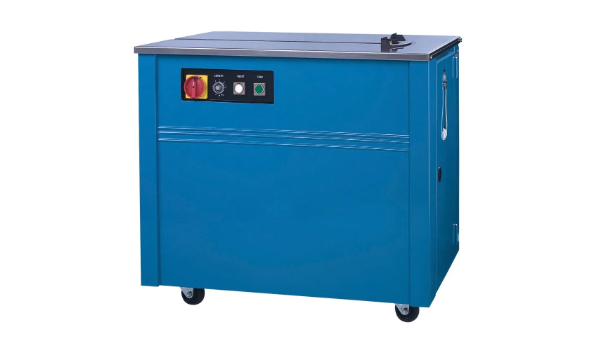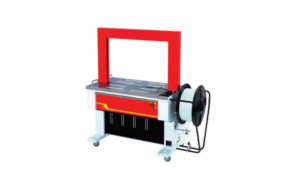
Strapping Machine
Do you need a strapping machine? If you’re strapping products and cartons together every day and then strapping those products to pallets, perhaps you’ve wondered whether a machine would make your operations more productive—and profitable.
Strapping machines benefit high-volume operations and are available in two types to strap packages: semi-automatic and fully automatic. They strap packages quickly and reliably. Your products are protected, and your staff gets more done.
You could also consider an automatic pallet strapping machine if the manual strapping of your pallets is causing production bottlenecks.
Your choice of strapping machine begins with the type of strap you’re using.
Strapping operations: types of strapping materials
The three most common types of strapping are:
- Steel strapping;
- Polypropylene (PP) strapping;
- Polyester (PET) strapping.
Steel strapping is widely used to secure heavy construction materials, as well as to secure packages in shipping containers and on railroad cars. It is available in many different widths and grades.
However, steel strapping has challenges, so over the years it has been replaced by various forms of plastic strapping because they’re more versatile and easier to use.
Highly versatile and cost-effective, polypropylene (PP) strapping is used in many industries and on many different types of strapping machines.
Polyester (PET) strapping is also widely used. More expensive than PP strapping, PET strapping can be manufactured in such high grades that it’s been called “synthetic steel.”
Before we look at how semi-automatic and automatic strapping machines work, let’s look at what happens in strapping.
Strapping: how it works
When strapping and bundling, consider the size, form, and weight of the products you’re strapping.
Perhaps you’re:
- Strapping cartons, so that their packaging is more secure, and won’t burst during shipping and handling.
- Strapping cartons together so that they need less space when stored and shipped.
- Strapping awkwardly-shaped bundles of products together. They may be heavy, such as steep pipes, or relatively lightweight, like plastic bottles.
- Securing cartons or items onto pallets
Once you know the type of strap you’re using and the items you’re strapping, you need not only the strapping but also a tensioner and a sealer.
The benefit of semi-automatic strapping machines is that they wrap, tension, and seal packages in one operation, more quickly and securely than can be done manually.
If you’re strapping several dozen packages in a day, a semi-automatic strapping machine saves time and materials. A machine also packages items more securely than can be managed in any manual operation.
But how does a semi-automatic strapping machine work?
How a semi-automatic strapping machine works
Semi-automatic packaging machines are available in many brands, in many sizes. Essentially, they’re a mobile table/ bench top.
They can be used anywhere because they’re small and easy to move from one area to another as required. They’re also available in several heights, so that you can place packages or products of different sizes and weights on the machine.
The operation is simple.
A package is placed on the machine, then the strap is looped around it and fed back into the machine. A sensor senses the insertion of the strap end and starts the machine. The machine does the rest: it tightens and tensions the strapping, seals it, and cuts it, all in one smooth operation.
If the package requires more than one strap, the operator turns the package on the machine’s table top. Then he winds the tape around the package again and feeds it into the sensor. He can add as many straps as the package needs.
Once the strapping operation is complete, the operator removes the package, then places another package on the machine.
Although semi-automatic machines are available to use different types of strapping and their speed of operation varies, generally they need two to three seconds to tension, seal, and cut one strap.
What if you need a faster operation? If you’re operating at high volumes, and consider a couple of seconds per strap too slow, consider an automatic strapping machine.
An automatic strapping machine: essential for large operations
Automatic strapping machines can apply 25 to 30 straps a minute.
While semi-automatic strapping machines operate with an open table top onto which packages are placed for the strapping operations, an automatic strapping machine needs a sensor to detect the size and shape of each package. Commonly, an arch over the top of the machine’s bench contains the machine’s sensor, so automatic machines are often called “arch strappers”.

Unlike a semi-automatic machine, an arch strapper needs no assistance. When a package is placed on it, it detects the dimensions of the package, then applies, tensions, seals, and cuts the strapping automatically.
Arch strappers are available in many different types. In lower-priced models, an operator sets the machine’s tension, then places the package and aligns it so that the machine can strap it. If you decide you need even faster strapping, you can buy machines with a feeder conveyor belt.
Choosing a semi-automatic strapping machine: get advice
If you decide you need a semi-automatic strapping machine, get advice from your packaging supplier. Not only do you have your choice of different brands, but each brand has various options for you to consider.



